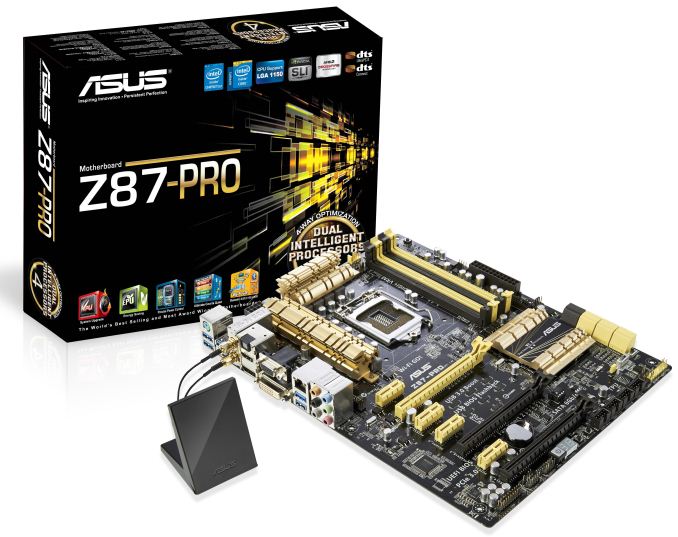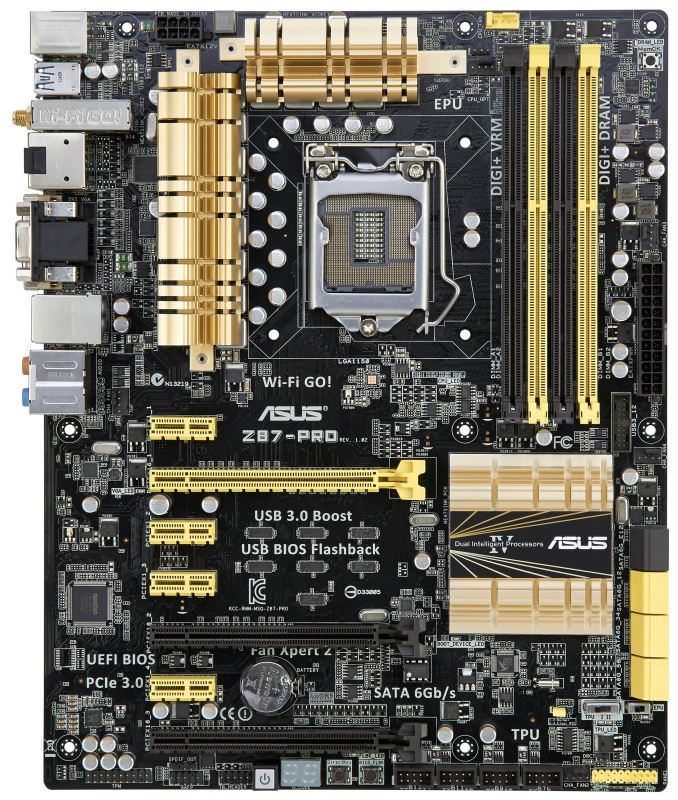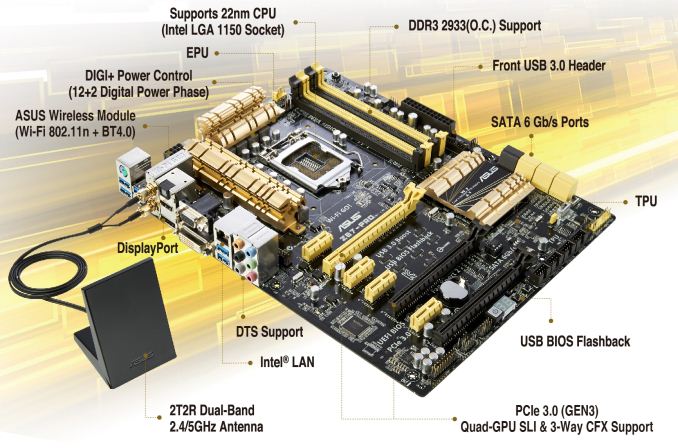Intel Z87 Motherboard Review with Haswell: Gigabyte, MSI, ASRock and ASUS
by Ian Cutress on June 27, 2013 8:00 AM EST- Posted in
- Motherboards
- Intel
- MSI
- Gigabyte
- ASRock
- Asus
- Haswell
- Z87
- Shark Bay
- Lynx Point
ASUS Z87-Pro Overview
With the new designs of the ASUS motherboards, we were all thrown a curveball. I for one did not expect ASUS to go with a gold/yellow color scheme, one that had up until this point been reserved for ECS’ Golden Series. The ECS range was built on the basis of China, the Middle East, India, and other emerging markets where Gold means status; this could imply, combined with the global downturn in motherboard sales (~80 million 2012, expected ~77 million 2013) that ASUS wants a piece of that pie. Nonetheless, the implementation from ASUS is a little less garish and obvious, by keeping a mainly black theme and not going too overboard on the styling.
Aesthetics aside, ASUS stepped up to the mound and are ready for another pitch (enough baseball metaphors here?). In the past we have been used to their innovative features including inter alia TPU, EPU, BIOS Flashback, and Z87 brings in the new generation. On the face of it we have an updated UEFI designed to look a little more contemporary, and now there is additional customization options to allow enthusiast users to organize the options they want into a separate menu. I found it particularly useful when testing the overclocks on the Z87-Pro. We also get a new version of AI Suite for the operating system which incorporates a slick design, simplifying overclocking and making the process a more pleasurable experience both physically and visually. Regular features such as Fan XPert, USB 3.0 Boost and the new Dual Intelligent Processors IV help the user improve the experience of the platform.
In terms of performance, the ASUS is quite efficient in our comparison tests, with good scores in the Windows 7 POST time (under 10 seconds), the audio (using a Realtek ALC1150), USB 3.0 speed, and dual 7970 Metro2033 power consumption was under 500W. There are a couple of issues worth noting –the PCIe layout of PCIe 3.0 x8/x8 + PCIe 2.0 x4 from the chipset requires the PCIe 2.0 x4 to be set in the BIOS, otherwise it will default to PCIe 2.0 x1. Because this x4 shares PCIe bandwidth with various controllers (such as the ASMedia SATA Controller), users have a choice between having the controllers and an x1 or just an x4. If users do not know this and attempt a three-way AMD GPU configuration, performance will suffer. But in any PCIe combination, two compatible NVIDIA GPUs will be able to perform SLI.
It is worth noting that ASUS is steering away from BIOSes that implement MultiCore Enhancement (their version of MultiCore Turbo). By default it will not be applied when XMP is applied for all BIOSes that start 1xxx. This would arguably give ASUS a 7% decrease in performance at stock in multi-threaded tests but ASUS’ reasoning is such that some of the Haswell i7-4770K CPUs, the ones that only just get into this category, will throttle the CPU speed when using the default Intel CPU cooler when MCT is enabled. In order to counteract this, MCT has been disabled by default. In order to accommodate users who want MCT by default, users can either implement it manually or download and install a 3xxx series BIOS for their ASUS motherboard. For our testing, as the 3xxx was available, we used the BIOS that implemented MCT.
Overclocking on the ASUS gets a different sort of boost when automatically overclocking – with the TPU DIP switch on board now offering two placements, we can have a high and low type of TPU overclock. The first one places a 4770K CPU at 43/43/42/41 multipliers, whereas the second uses the 125 MHz gear strap for 34x125 (4250 MHz) on all cores. Manual overclocking was also relatively easy, with ASUS putting their usual high effort into making sure that Automatic settings for options like Load Line Calibration work very well, leaving the user to make minimal changes to get the speed they want. Our CPU hit 4.7 GHz, similarly to the other motherboards in this review, with a peak temperature in Celsius in the low 90s with our TRUE Copper CPU cooler. I did notice however that there is a difference in the temperature reported by AI Suite and OCCT of around 10C as ASUS uses a combination of the internal CPU sensor and their own on-board socket sensor to report the value.
By comparing the specification sheet of the ASUS and the ASRock, in terms of pure port numbers, the ASRock wins out, but there is a dichotomy depending on what the user wants – the ASRock has 802.11ac, but the ASUS has a better automatic overclock system and all the 4-pin fan headers are fully controllable (with good software to boot). The ASRock has HDMI-In, XFast and dual Intel NICs, whereas the ASUS has Mem_OK, BIOS Flashback, DirectKey and a TB_Header if you can get hold of a Thunderbolt add-in card. As these boards are around the same MSRP (within $10 at launch), a user is going to go for the board that either fits their needs most, or looks better, for which the ASUS wins based on their matte black finish.
Visual Inspection
Obviously what strikes at first glance is the color scheme, with ASUS aiming for various portions of the market with their gold/yellow/mustard livery. I would point out that it is not completely overdone, whereby the socket and rear IO are default silvery colors. Obviously the heatsinks are not coated with real gold, this is just a color.
The socket area is right at the Intel specifications next to the power delivery, but we have a little extra space to the DIMMs and the sockets below. The VRM heatsinks are swathed in that gold color, and perhaps a little surprisingly these heatsinks are not heatpiped together, despite a 12+2 phase solution being used. In is helpful though that the memory slots on the Pro are the only ones in this review that are using the single sided latches.
The socket area has access to four fan headers with immediate reach, or five at a stretch, for a total of six on board and all of them are 4-pin headers. The main two for the CPU are between the power delivery heatsinks and the memory slots, with the main CPU fan header using a new design to detect between different sorts of 4-pin fan (PWM, voltage). A third 4-pin is to the bottom left of the socket area near the IO, and a 4-pin header is found either side of the 24-pin ATX power connector. The final 4-pin header is on the bottom of the board sandwiched between the front panel header and USB 2.0 headers.
Moving clockwise around the motherboard and we reach the 24-pin ATX power connector surrounded by two of the aforementioned 4-pin fan headers but also a USB 3.0 header. Beneath these are our eight SATA 6 Gbps ports – six from the PCH in yellow and two from an ASMedia controller in black. The ASMedia SATA ports share connectivity with the PCIe 2.0 x4 slot on board, and are disabled when the PCIe 2.0 x4 slot is set to x4 rather than x1 by default.
The TPU and EPU switches come next, with the two-stage TPU clearly labeled (but might be overcast if two double length GPUs are used). From right to left along the bottom of the board we have a front panel header, a 4-pin fan header, four USB 2.0 headers, a BIOS_Flashback button, a DirectKey button, a two-digit debug LED, a power button, the Thunderbolt header for an add-in card, a front panel audio header and a TPM header. Aside from the lack of a reset button (which helps a lot during my testing), it will be worth pointing out the DIrectKey button – this allows a user to restart go straight into the BIOS at the next boot, and holding the button down will cause the system to hard shutdown.
The PCIe layout comes about as regular as they get, with the full length lanes supporting PCIe 3.0 x16 or x8/x8, and the final slot supporting PCIe 2.0 x4. We also have four PCIe 2.0 x1 slots onboard.
The rear IO on board consists of a PS/2 combination port, a total of six USB 3.0, a WiFi module (2x2:2, dual band a/b/g/n with Bluetooth 4.0), all four video outputs, an Intel NIC and audio jacks.
Board Features
| ASUS Z87-Pro | |||||||
| Price | Link | ||||||
| Size | ATX | ||||||
| CPU Interface | LGA-1150 | ||||||
| Chipset | Intel Z87 | ||||||
| Memory Slots |
Four DDR3 DIMM slots supporting up to 32 GB Up to Dual Channel, 1066-3000 MHz |
||||||
| Video Outputs |
D-Sub DVI-D DisplayPort HDMI |
||||||
| Onboard LAN | Intel NIC | ||||||
| Onboard Audio | Realtek ALC1150 | ||||||
| Expansion Slots |
2 x PCIe 3.0 x16 (x16, x8/x8) 1 x PCIe 2.0 x4 (x1 by default) 4 x PCIe 2.0 x1 |
||||||
| Onboard SATA/RAID |
6 x SATA 6 Gbps (PCH), RAID 0, 1, 5, 10 2 x SATA 6 Gbps (ASMedia), RAID 0, 1 |
||||||
| USB |
4 x USB 3.0 (PCH) [1 header, 2 back panel] 4 x USB 3.0 (ASMedia) [4 back panel] 8 x USB 2.0 (PCH) [4 headers] |
||||||
|
Flex IO x+y+z = 18 |
|
||||||
| Onboard |
8 x SATA 6 Gbps 1 x USB 3.0 Header 4 x USB 2.0 Headers 6 x Fan Headers Mem OK! Button BIOS Flashback Button DirectKey Button Power Button Two-Digit Debug LED 1 x TPM Header 1 x TB_Header Front Panel Header Front Panel Audio Header |
||||||
| Power Connectors |
1 x 24-pin ATX Power 1 x 8-pin CPU Power |
||||||
| Fan Headers |
2 x CPU (1 x 4-pin detection, 4-pin) 4 x CHA (4-pin) |
||||||
| IO Panel |
1 x PS/2 Combination Port 6 x USB 3.0 WiFi-Go Module D-Sub DVI-D HDMI DisplayPort SPDIF Output Intel NIC Audio Jacks |
||||||
| Warranty Period | 3 Years | ||||||
| Product Page | Link | ||||||
As ASUS are the only manufacturer with features such as Mem-OK, BIOS Flashback, TPU, EPU and an IO mounted WiFi module, sometimes it is hard to quantify the worth in comparison to other manufacturers. Clearly there is significant engineering work taking place to make such functions happen, and if it requires bandwidth it often gives the potential for other manufacturers to steam ahead with more NICs, more USB ports and more SATA ports. The value in such hardware designs is partly reflected in price, but it also has to be vital in the eyes of the user.














58 Comments
View All Comments
ShieTar - Thursday, June 27, 2013 - link
Is there a special reason not to test the POST times and DPC latency of the Gigabyte Board? Its power consumption is quiet impressive, and whatever design measures have been used to achieve it do not seem to negatively affect the overall performance. So it would be interesting to complete the picture with the two measurements which are missing.IanCutress - Thursday, June 27, 2013 - link
DPC Latency on the Gigabyte during testing was jumping around a fair bit, hitting 800+, though that is more likely due to the early BIOS revision. I need to run the POST test (as the results are strangely missing from my database) as well as the DPC test on a newer BIOS. Since I started testing almost every manufacturer has released newer BIOSes (as is always the way coming up to a launch) and I really have to lay the hammer down as testing a whole new BIOS takes a good 30 hours or so start to finish, so when I'm locked in that's it. That in a way does give an unfair advantage to the board I test last, but there's not a lot else I can do. I am still getting emails of BIOS updates for these boards as of yesterday.Ian
tribbles - Thursday, June 27, 2013 - link
Am I wrong in thinking that Gigabyte hasn't been doing well in the DPC Latency Test since Z77? If so, that's kind of surprising, since Gigabyte seems to be a "go-to" brand for digital audio workstation builders.IanCutress - Wednesday, July 10, 2013 - link
I retested the UD3H on the F5 (public) BIOS, and it scored 164. The two next boards I have in for review got 160 and 157, which points fingers to the DPC on Haswell being 150+ regardless of motherboard. This might be a fundamental issue.Timur Born - Saturday, July 27, 2013 - link
Run Prime95 (or turn off CPU power features) while measuring DPC latencies to see how much CPU power saving features affect DPCs.jhonabundance - Thursday, August 28, 2014 - link
great share http://asus.comjhonabundance - Thursday, August 28, 2014 - link
this is the best share http://asus.comRick83 - Thursday, June 27, 2013 - link
Maybe a bad choice to use two different ways of graphing the Rightmark results.Being consistent with regard to cutting off the irrelevant bit of the graph makes it a much easier read.
Now it appears at first glance as though the Gigabyte board is much better in THD+N, simply because the differences were so minuscule in the dynamic range bit.
On another note: Shouldn't it be more interesting to use a standardized input instead of the input of the board? In the current protocol a good output could be handicapped by a bad input, and conversely. For most users the output is much more important than the input, so it might be better to test it independently? I would recommend using a USB soundcard as an easy means of doing this test on the same machine, without changing the setup protocol too much.
And finally - I seem to remember Rightmark results for earlier reviews - it would be interesting to have those (or maybe a reference soundcard?) as comparison in the same graph. After all, for DPC you maintain a large cross-platform table as well.
Nice thorough initial review, those nitpicks withstanding.
IanCutress - Thursday, June 27, 2013 - link
Unfortunately I can't adjust the engine to represent from 0 for negative values, I don't have access to the low level options. I forwarded it on as an issue.I'd love to use a standardized input with RMAA. I guess it would be good to get a sound card with an input that supercedes the output of the motherboard and put it through that way, and hopefully there won't be a driver conflict along the line. I'll see what I can do to get in the hardware for that, although many soundcards are designed more for output and the input dynamic range/distortion might be the limiting factor as is the case on motherboards. Something like the Xonar Essence STX has a 118 dBA input with -113 dBA THD+N which might be a good starting point.
Our RMAA testing for Z87 has changed a little from Z77 to make it more of an efficiency test rather than an out-the-box test as audio is such a varied playing field. RMAA is very sensitive to certain windows settings and volumes for example such that with the right combination it was very easy to show A>B or B>A depending on how the OS felt it should be set up. The new testing regimen for RMAA should iron out those issues but the results are not exactly comparable to Z77 for that reason. There are so many wrong ways to set up RMAA it can be difficult (and a learning experience) to get it right.
Ian
popej - Thursday, June 27, 2013 - link
Nice to see you are planning steps in right direction. Using reference card for measurements is a proper solution. Be aware, that separate card add complications to the test, for example you will have to take care about ground loops and signal level matching. Professional card with balanced input could help a lot.